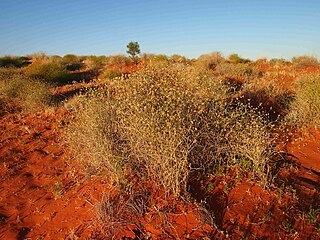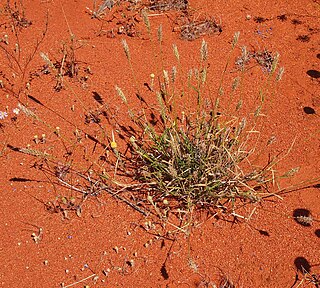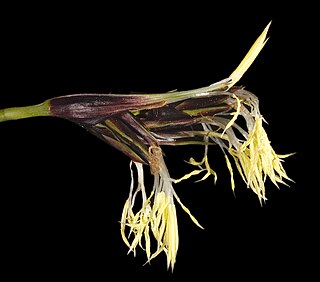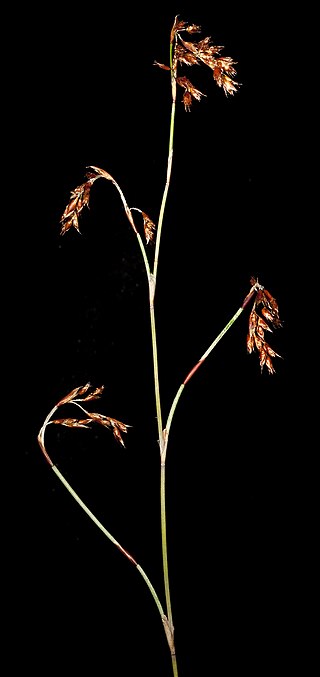
Christian Gottfried Daniel Nees von Esenbeck was a prolific German botanist, physician, zoologist, and natural philosopher. He was a contemporary of Goethe and was born within the lifetime of Linnaeus. He described approximately 7,000 plant species. His last official act as president of the German Academy of Natural Scientists Leopoldina was to admit Charles Darwin as a member. He was the author of numerous monographs on botany and zoology. His best-known works deal with fungi.

Zygochloa is a genus of desert plants in the grass family known only from Australia. The only known species is Zygochloa paradoxa, commonly known as sandhill canegrass. It occurs in extremely arid areas such as the Simpson Desert.

Neolitsea dealbata, also known as white bolly gum, hairy-leaved bolly gum, or simply bolly gum, is a shrub or small tree in the laurel family Lauraceae which is native to New South Wales and Queensland in Australia.
Triglochin trichophora is an annual herb native to Australia.

Olearia ramulosa, commonly known as twiggy daisy-bush, is a species of flowering plant in the family Asteraceae and is endemic to south-eastern Australia. It is a shrub with narrowly elliptic, linear or narrowly egg-shaped leaves, and pale blue, mauve or white and yellow, daisy-like inflorescences.
Plinthanthesis is a genus of Australian plants in the grass family.

Anisopogon is a genus of Australian plants in the grass family. The only known species is Anisopogon avenaceus, native to Victoria and New South Wales. It is known commonly as oat speargrass. It is a perennial grass growing up to 1.5 metres tall, bearing spikelets up to 6 centimetres long.

Amphibromus is a genus of grasses in the family Poaceae. Most are known as swamp wallaby grass. Most are endemic to Australia. One can also be found in New Zealand and there are two species in South America.

Streptochaeta is a genus of plants in the grass family. It is the only genus in the tribe Streptochaeteae of the family Poaceae.

Thyridolepis is a genus of Australian plants in the family Poaceae.

Hygroryza (watergrass) is a genus of Asian plants in the grass family.
Carex preissii is a flowering plant in the sedge family, Cyperaceae, that is native to Western Australia.

Lawrencia squamata is a species of plant in the mallow family, Malvaceae. It is endemic to Australia and occurs in all Australian states.

Tetraria octandra is a sedge, which is native to the south-west of Western Australia.

Poa drummondiana is a perennial herb in the Poaceae family.

Cassytha racemosa is a parasitic perennial in the Lauraceae family. It is found in Western Australia.

Gyrostemon subnudus is a plant in the family, Gyrostemonaceae. It was first described as Amperea subnuda in 1848 by Nees von Esenbeck, and transferred to the genus, Gyrostemon in 1873 by Henri Ernest Baillon.

Ptilotus humilis is an annual herb in the Amaranthaceae family, native to Western Australia. It was first described as Trichinium humile by Nees von Esenbeck in 1845 but was transferred to the genus, Ptilotus, by Ferdinand von Mueller in 1868.

Leptocarpus coangustatus is a species of plant in the Restionaceae (rush) family, endemic to Western Australia.

Schoenus nanus is a species of sedge endemic to Australia, and found in Western Australia, South Australia and Victoria. It was first described in 1844 by Christian Gottfried Daniel Nees von Esenbeck as Chaetospora nana, but in 1878 was transferred by George Bentham to the genus, Schoenus.

















